| |
| Art
& Culture |
| Kashmir |
| Sufism |
Jammu
& Kashmir is one place where the roving eyes
of travelers come upon one endearing natural vista
after another. A visit to this Eden revitalizes
everyone - body, mind & soul. Over the centuries
saints, seers and followers of all religions have
come to Kashmir and left it richer, more spiritually
robust. Jammu and Kashmir is dotted by both natural
and man made religious pilgrimage sites. Shrines
of all faiths exist in a good number here, symbolizing
the spiritual and secular character of the Region.
Hundreds of Shrines placed in scenic locations
all over its hilly landscape. |
| |
| Origins of Sufism in Kashmir |
Sufism is a
mystic tradition within Islam and encompasses
a diverse range of beliefs and practices dedicated
to divine love and the cultivation of the heart. |
Jammu &
Kashmir, the land renowned for its scenic splendors,
has been endowed with a rich lineage of Sufi tradition.
It is dotted by innumerable Sufi Shrines, which
are held in high devotional esteem by people of
all religious faiths. These sacred places, today,
have become synonyms of religious secularism and
brotherhood and symbols of Hindu, Muslim and Sikh
unity within Kashmir, Jammu and Ladakh.
|
The Sufi Pirs,
Rishis and Saints preached the doctrine of love,
compassion and humanity and espoused the cause
of peace among people.
|
The great
Sufi Saints of Kashmir like Hazrat Bulbul Shah,
Amir-e-Kabir Shah-e-Hamdan, Noor-ud-Din Wali,
Lal Ded, Baba Rishi, Baba Budhan Shah, Roshan
Ali Shah, Peer Mitha and Panj Peer, who had followers
in Kashmir as well as the rest of the country
are revered every where.
|
| |
| Kashmir Handicrafts |
From the amusing
trinket to a collector's item, you'll find it
all in Srinagar. Row upon row of shops filled
with handicrafts line the streets.The array is
awesome. There are objects to suit every pocket,
for the variety within each craft is wide.
|
 |
Kashmiri handicrafts
are prized everywhere for their exquisite craftsmanship.
Kashmir carpets, in both wool and silk with their
Persian design, are a lifetime investment and
the shoppers' selection range from the simple
to the most extraordinarily intricate patterns
handed down the generations. Then there are paper
mache items ranging from Jewellery boxes to mirror
frames, a range of intricately carved walnut wood
furniture and accessories, stone Jewellery boxes,
beautiful woolen shawls, crewel embroidery on
furnishing material sold by the meter and more.
|
| |
| Carpet |
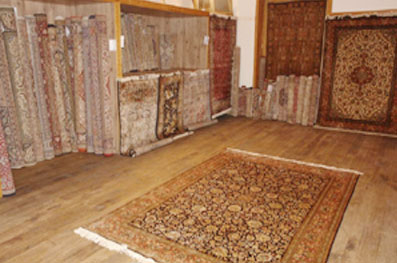 |
A carpet may
well be the most expensive purchase from your
trip to Kashmir but it is a lifelong investment.
Kashmiri carpets are known the world over for
two things - they are handmade, never machine
made, and they are always knotted, never tufted.
It is extremely instructive to watch a carpet
being made - your dealer can probably arrange
this for you.
|
The yarn used
normally is silk, wool or both. Staple carpets
are made to fill a slot in the market - customers
demand carpets, which are not unlike silk in appearance
so as to blend with the decor of their houses.
One important difference between silk and staple
though is that pure silk is far lighter than staple
per unit area.
|
Carpet weaving
in Kashmir was not originally indigenous but is
thought to have come in by way of Persia. Till
today, most designs are distinctly Persian with
local variations
|
The knotting
of carpet is the most important aspect, determining
its durability and value, in addition to its design.
Basically, the more knots per square inch, the
greater its value and durability. Count the number
of knots on the reverse of carpet in any one square
inch, and it should be roughly the same as the
dealer tells you, give or take 10 knots.
|
| |
| Namdas |
Far less expensive
are these colorful floor coverings made from woolen
and cotton fiber which have been manually pressed
into shape. Prices vary with the percentage of
wool - a namda containing 80 per cent wool being
more expensive than the one containing 20 per
cent wool. Chain-stitch embroidery in woolen and
cotton thread is executed on these rugs.
|
| |
| Chain Stitch And Crewel Furnishings |
Because of
the high quality of embroidery done on wall hangings
and rugs,Kashmiri crewel-work is in great demand
throughout the world. Chain stitch,be it in wool,
silk or cotton, is done by hook rather than by
needle. The hook is referred to as aari, and while
maintaining the same quality, hook work covers
a much larger area than needle work in the same
amount of time.
|
All the embroidery
is executed on white cotton fabric, pre-shrunk
by the manufacturers. The intrinsic worth of each
piece lies in the sizes of the stitches and the
yarn used.
|
Crewel is
basically similar to chain stitch. It is also
chain stitch done on white background, but here
the motifs, mainly stylized flowers, do not cover
the entire surface, and the background is not
embroidered upon.
|
| |
| Papier Mache |
| At first
glance, all paper mache objects look roughly the
same, but there is a price differential which
depends on the quality of the product. However,
besides at least three different grades of paper
mache, some are actually cardboard or wood! The
idea, however, is not to hoodwink the unwary,
but to provide a cheaper product with the look
of paper mache.
|
The designs
painted on objects of paper mache are brightly
colored. They vary in artistry and the choice
of colors, and it is not difficult to tell a mediocre
piece from an excellent one. Gold is used on most
objects, either as the only colour, or as a highlight
for certain motifs. Besides the finish of the
product, it is the quality of gold used which
determines the price. |
| |
| Shawls |
There are three
fibres from which Kashmiri shawls are made - wool,
pashmina and shahtoosh. The prices of the three
cannot be compared - Woolen shawls being within
reach of the most modest budget, and Shahtoosh
being a one-in-a-lifetime purchase. Shahtoos is
a banned commodity nowadays. |
Woolen shawls
are popular because of the embroidery worked on
them, which is unique to Kashmir. Both embroidery
and the type of wool used bring about differences
in the price. Wool woven in Kashmir is known as
raffle.
|
Many kinds
of embroidery are worked on shawls. 'Sozni' (needlework)
is generally done in a panel along the sides of
the shawl. Motifs, usually abstract designs or
stylized paisleys and flowers are worked in one
or two, and occasionally three subdued colors.
The fineness of the workmanship and the amount
of embroidery determines the value of the shawl.
|
Pashmina is
unmistakable due to its softness. Pashmina yarn
is spun from the hair of goat found in the highlands
of Ladakh, at 14,000 ft above sea level. It is
on pashmina shawls that Kashmir's most exquisite
embroidery is executed, sometimes covering the
entire surface, earning it the name of 'jamawar'.
A Jamawar shawl can, by virtue of the embroidery,
increase the value of a shawl threefold.
|
A second,
less frequently seen weave done only on pashmina,
covers the surface with tiny lozenge shaped squares,
earning it the delightful name of 'chashm-e-bulbul,'
or "eye of the bulbul". As this weave
is a masterpiece of the weaver's art, it is normally
not embroidered upon.
|
| |
| Copper and Silverware |
The old city
abounds with shops where objects of copper line
the walls, the floor and even the ceiling, made
generally for the local market. Craftsmen can
often be seen engraving objects of household utility
- samovars, bowls, plates and trays. Floral, stylized,
geometric, leaf and sometimes calligraphic motifs
are engraved or embossed on copper and occasionally
silver, to cover the entire surface with intricate
designs which are then oxidized, so as to stand
out better from the background. The work, known
as 'naqashi', determines the price of the object,
as does the weight.
|
| |
| Basketry |
| Willow rushes
that grow plentifully in marshes and lakes in
Kashmir are used to make charmingly quaint objects,
ranging from shopping baskets and lampshades to
tables and chairs, all generally inexpensive.
To increase their life span, unvarnished products
should be chosen and frequently sprayed with water,
particularly in hot, dry climates, to prevent
them becoming brittle.
|
| |
| Wood Carving |
 |
Kashmir is
the only part of India where the walnut tree grows.
Its color, grains and inherent sheen are unique
and unmistakable, and the carving and fret- work
that is done on this wood is of a very superior
quality. |
Chinar leaves,
vine leaves and flowers can be either carved along
borders or can fill entire surfaces. The artistry
of the carving and its abundance dictates the
cost. Trinket boxes and the larger Jewellery boxes
should have invisible seams. Other walnut wood
objects are salad bowls, nut bowls, photo frames,
trays and furniture, which range from simple telephone
tables to elaborate dining tables with six chairs.
In the case of furniture, the price is dictated
by the thickness of wood used.
|
| |
| Traditional Folk |
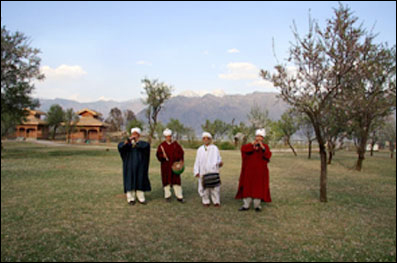 |
| |
| Ladakh |
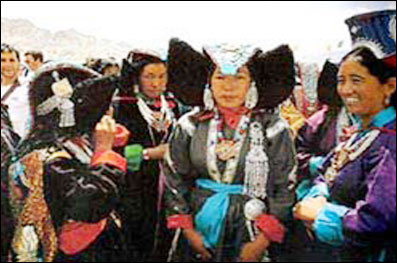 |
The people
of Ladakh, by and large, exhibit a natural joie-de-vivre,
which is given free rein by the region's ancient
traditions. Socio-religious festivals, including
the annual festivals held in the monasteries,
provide the excuse for convivial gatherings. Archery
is a pastime for all in summer. Among the Buddhists
this sport often takes the form of open-air parties
accompanied by dance and song. The game of polo
is yet another proud element of the popular culture.
|
| |
| Archery and Polo |
Archery is
an ancestral sport of Ladakh, which is part of
the culture. In Leh and its surrounding villages,
archery festivals are held during the summer months,
with a lot of fun and fanfare. They are competitive
events, to which all the surrounding villages
send their teams. The sport itself is conducted
with strict etiquette, to the accompaniment of
the music of surna and Daman (oboe and drum).
As important as the sport itself are the interludes
of dancing and other entertainment. Chang, the
local barley beer,flows freely, but there is rarely
any rowdiness. The crowds attend in their Sunday
best, the men invariably in traditional dress
and the women wearing their brightest brocade
mantles and their heaviest Jewellery. Archery
may be the pretext for the gathering, but partying
is the thing. In Kargil area, on the other hand,
the archery competitions are more serious and
bereft of the dancing and music, and these are
held in early spring, at the time of the thawing
of the winter snow and frost.
|
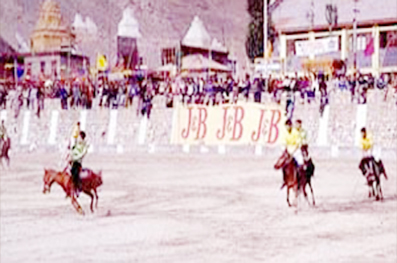 |
Polo, the
other traditional sport of Ladakh is indigenous
to the western Himalayas, especially to Baltistan
and Gilgit. It was probably introduced into Ladakh
in the mid-17th century by King Singge Namgyal,
whose mother was a Baltic princess. The game played
here differs in many respects from the international
game, which is adapted from what British travelers
saw in the western Himalayas and Manipur in the
19th century. Each team consists of six players,
and the game lasts for an hour with a ten-minute
break. Altitude notwithstanding, the hardy local
ponies - the best of which come from Zanskar -
scarcely seem to suffer, though play can be fast
and furious. Each goal is greeted by a burst of
music from surna and daman, and the players often
show extraordinary skill. Unlike the international
game, polo in Ladakh is not exclusively for the
rich.
|
Traditionally,
almost every major village had its polo-ground,
and even today it is played with verve in many
places besides Leh, especially in Dras and Chushot
near Leh. In Leh town itself, it has been partly
institutionalized with regular tournaments and
occasional exhibition matches being played on
the polo-ground. The local crowd takes a keen
interest, especially in those matches in which
a civilian team takes on that of the army. Altogether,
polo adds a unique kind of color and excitement
to the summer in Leh.
|
The tradition
of artistic craftsmanship in Ladakh is not as
well developed as in neighboring Kashmir, and
most of the luxury articles are obtained through
imports. The exception is the village of Chilling,
about 19 km up the Zanskar River from Nimo, where
a community of metal workers carries on their
ancestral profession, working with silver, brass
and copper. These are said to be the descendants
of artisans brought from Nepal during the mid-17th
century to build one of the gigantic Buddha -
images at Shey. They produce exquisite items for
domestic and religious use, such as tea and chang
pots, teacup-stands and lids, hookah-bases, ladles,
bowls and occasionally, silver chortens for temples
and domestic shrines.
|
| |
| A Brass Kettle from Ladakh |
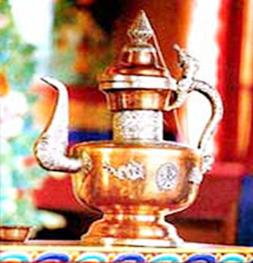 |
Items of everyday
use such as cooking pots and bowls, as well as
agricultural implements are supplied by local
blacksmiths (gara). They also make the large and
ornate iron stoves seen in kitchens of the Ladakhi
homes. Craftsmanship in general has not developed
beyond the production of everyday items for domestic
use. Pattu, the rough, warm, woolen material used
for clothing is made from locally produced wool,
spun by women on drop-spindles, and woven by traditional
weavers on portable looms that are set up in the
winter sunshine or under the shade of a tree in
summer. Baskets, for the transport of any kind
of burden, are woven out of willow twigs or a
particular variety of grass. Woodwork is confined
largely to the production of pillars and carved
lintels for the houses and the low carved tables
or Chog-tse that are a feature of every Ladakhi
living room.
|
| Buddha |
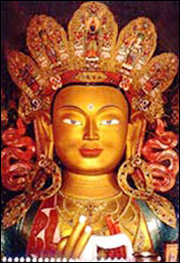 |
Many such
items, including newly introduced varieties, are
available in the Government Handicrafts Centre
at Leh. There you can find, in addition to traditional
objects, a few special items like pure pashmina
shawls, rough compared with those produced in
Srinagar, and carpets with Tibetan designs. Similar
carpets can also be purchased at the Tibetan Refugee
Centre, Choglamsar. The Handicrafts Centre also
has a department of thangka painting. These icons
on cloth are executed in accordance with strict
traditional guidelines handed down the generations.
|
In the same
tradition are the mural paintings in the monasteries,
where semi-professionals, both monks and laymen,
toil to keep the walls decorated with images symbolizing
various aspects of Buddhism. The skill of building
religious statues is also not extinct. The gigantic
image of Maitreya Buddha was installed in Thiksey
Gompa as recently as the early 1980s. |
| |
| Oracles and Astrologers |
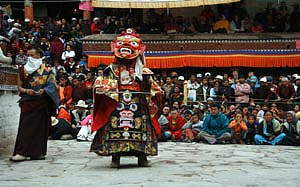 |
The people
of Ladakh, particularly the Buddhists, believe
implicitly in the influence of gods and spirits
on the material world, and undertake no major
activity without taking this influence into consideration.
The lamas are the vital intermediaries between
the human and the spirit worlds. Not only do they
perform the rites necessary to propitiate the
gods, but they also take on the role of astrologers
and oracles who can predict auspicious time for
starting any work, whether sloughing the fields,
or taking in the harvest, arranging a marriage
or going on a journey.
|
The most famous
monk-oracles are those of Matho Gompa. Chosen
every three years by a traditional procedure,
two monks spend several months in a rigorous regimen
of prayer and fasting to prepare and purify themselves
for their difficult role. When the time comes
they are possessed by the deity known as Rong-tsan,
whose spirit enables them to perform feats that
would be impossible to anyone in a normal state
such as cutting themselves with knives, or sprinting
along the Gompa's topmost parapet. In this condition,
they will answer questions concerning individual
problems and public welfare. However, the spirit
is said to be able to detect questions asked by
skeptical observers for testing him, to which
they react with frenzied anger.
|
| |
| Monestic Dance |
 |
In some villages
there are also lay people who have special powers
as oracles and healers. Some of them belong to
families in which there have been several such
recipients of spirit forces, while others do not
have any such hereditary background. The spirits
possessing these layperson's are believed to be
unpredictable, and not always entirely benevolent,
and some people resist being possessed by them.
However, once they have accepted, they undergo
a process of initiation and training by monks
and senior oracles before they are able to start
practicing.
|
| |
| JAMMU |
| Museums |
| Amar Mahal Museum |
Amar Mahal
Palace is located near the Mubark Mandi complex.
Built like a French Chateau on a hill overlooking
the river Tawi it was constructed over a hundred
years back and at present houses a museum. The
exhibits include Pahari paintings, family portraits
of the rulers of Jammu and Kashmir, and a library.
The museum also conducts a "heritage walk"
programme for interested student to familiarize
them with the history of Jammu.
|
| Dogra Art Gallery, Mubarak Mandi
Complex |
 |
| |
| Folk Music/Song/Dance |
| Bakhan |
This folk
song is a widely prevalent form of mass entertainment
in our region. The haunting Melody of Pahari songs
add to the beauty and joy of daily life. There
are certain songs which are independent of instruments.
"Bakhan" is such a best example. "Bakhan"
are in verse. The metre is irregular and is determined
by modulation in tone. The movement of hand indicates
the variations in the note. This is the only form
of lyric in Dogri which resembles the Western
harmony of sounds without loosing its individual
note and rhythm.
|
| |
| Geetru |
A dance-song
of Dogra Pahari region of Jammu being performed
at the occasion of feasts, festivals and marriages
by the rural folk parties of this region. Male
and female both participate in this dance-song
in their traditional costumes. This type of dance-song
is performed at any time of the day as well as
night. Performing Arts.
|
| |
| Kud |
It is basically
a ritual dance performed in honour of Lok Devatas.
This dance style is performed mostly during nights.
It is spontaneous dance and people of all ages
and sexes participate in this folk dance form.
Instruments used during this dance are Narshingha,
chhaina, flute, drums etc. It is the rhythm of
music which contrils the movement of participants.
This dance continues for the whole night. Number
of participants ranges from 20 to 30 members.
|
| |
| Heren |
It is a traditional
theatre form performed during Lohri festival by
10-15 members. This style is mostly performed
in hilly regions of Jammu.
|
| |
| Fumenie and Jagarana |
This dance
style is performed by the ladies on the eve of
groom's departure to in-laws house. Both the songs
are sung by a group of females consisting 15-20
members. This traditional dance form depicts the
feelings and emotions of women folk. |
| |
| Surma |
This song
in Dogri, set to dance reveals the anguish of
a newly married girl whose husband is away in
the Army. The ever increasing yearning of re-union
is depicted through this song-dance. |
| |
| Bakh/Gwatri/Kark/Masade |
| It is a chorus narrative singing
sung by a group of 10 singers without the accompaniment
of any musical instruments. |
| |
| Gwatri |
It is a singing/
dance combined tradition in which the singers
narrate some text which is enacted by the Gwatari
dancers.
|
| |
| Karak |
| It is a tale ballet singing form
sung by a community called 'Jogies'. They narrate
a popular folk tale in their dance style, performed
by three members with accompaniment of typical folk
instrument called 'Rabab'. |
| |
| Benthe |
This is chzorus
singing tradition performed specific community
of trible called Gujjar and Bakerwal. Dance is
performed by 5-7 members.
|
| |